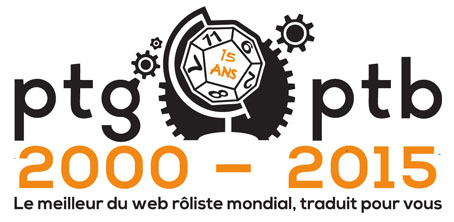A very easy trap to fall into as a GM is prepping the PCs’ actions: “When the PCs do X, this is what will happen.”
It’s easy because this is largely what an actual RPG session will look like: The PCs will do stuff and then other stuff will happen as a result of that. (Repeat.) It’s a trap because this only works if you’ve guessed exactly what the PCs will do.
That’s a problem because (a) you probably don’t have the gift of prescience and, therefore, (b) you almost certainly won’t guess correctly. (Or, at least, not a majority of the time.) At that point, your prep is going to start falling apart quickly and you’ll only have a few options:
- Start railroading the players and force them to do the things you prepped for them to do. (This is awful. It’s antithetical to the entire reason we play roleplaying games in the first place and your players will hate it.)
- Do lots and lots of contingency planning: Since the PCs might do lots of different things, you just need to make preparations for everything they might do! (Unfortunately, this will just result in a lot of wasted prep and the players are still likely to do something completely different.)
- Throw out most or all of your prep and just start improvising like mad in a desperate attempt to keep up with your players!
None of these are particularly appealing options, but at least the third one is steering us in the right direction. Throwing everything out and flying by the seat of your pants, though, is an incredibly daunting prospect, and if we’re just going to end up throwing everything out anyway, shouldn’t we just abandon prep entirely? Maybe embrace a zero prep approach and hope for the best?
But I have good news. The only reason this is daunting is because you’re having to throw out all of your prep. And the only reason you’re having to throw out all your prep is because you prepped the wrong stuff. (Or, at the very least, you prepped it in the wrong way.)
There’s a better way.
Your prep can empower you rather than trapping you.
THE TRAP
The most extreme version of prepping the PCs’ actions is prepping a linear plot, with a specific structure of PCs do A → PCs do B → PCs do C, but it’s not the only one.
To show you what I mean, we’re going to take a look at “Out of the House of Ashes,” a scenario from The Zalozhniy Quartet, a Night’s Black Agents campaign by Gareth Hanrahan and Kenneth Hite.
SPOILERS FOR THE ZALOZHNIY QUARTET!
To be clear, this is a very good scenario in a very good campaign. I like this scenario quite a bit and recommend the campaign book. That’s why it makes such a good example.
The basic situation in “Out of the House of Ashes” is that an ex-KGB agent named Arkady Shevlenko has valuable information related to a vampiric conspiracy. Shevlenko is currently attending a trade conference in Vienna, where he is planning to defect to the CIA. The vampires, on the other hand, have very different plans: In an operation led by Sergei Rachov, they interrupt the CIA’s plan to extract Shevlenko, kill the CIA team, and convince Shevlenko to give them the information instead.
The PCs, of course, also want the information, and the designers consider a lot of different options for what the players might do and give the GM several contingency plans for likely variations of how events might play out.
But it’s nevertheless clear that the spine of the adventure is still built around a loose-but-intended plot (i.e., a series of specific actions the PCs will take):
- The PCs become aware of Arkady Shevlenko and the information he has. (Several potential hooks are given, but one involves tracking an agent of the vampires named Sergei Rachov.)
- The PCs arrive in Vienna and put Arkady under surveillance.
- The PCs make contact with an MI-6 agent who chaperones them through a cut scene where they witness the vampires kill the CIA team.
- The PCs contact Shevlenko.
- The PCs extract Shevlenko from a performance of Marschner’s Der Vampyr at the Vienna State Opera.
And because the prep is structured around these specific PC actions, it all becomes surprisingly fragile. In other words, even through Hanrahan and Hite have included tons of useful options for the GM to use because they want the players to be free to approach the operation in any way that the players want, the fact that the material they’ve prepped is still organized around the plot (and presented via scenes triggered by the PCs’ actions) makes it incredibly difficult to actually use.
For example, let’s consider one deviation the PCs might make from the anticipated sequence: Instead of arriving in Vienna and then following Arkady Shevlenko, they instead put Sergei Rachov under surveillance to figure out what he’s doing.
This should be fairly straightforward, but what do I need from the book to pull this off in actual practice?
- Page 57 & 67: Rachov visits Dr. Ingolf, Shevlenko’s heart doctor. (Page 69: This includes giving him a vial of blood.)
- Page 73: He goes to a safe house on Veronikagasse.
- Page 68: He checks a dead drop where Dr. Ingolf leaves information for him.
- Page 63: On the evening of the next day, Rachov is at a reception at the Hotel Europe.
- Page 71: Rachov meets with a vampire named Simon Thonradel.
- Page 66: Rachov is at the Russian Embassy, meeting with Shevlenko.
- Page 76: Rachov attends Der Vampyr with Simon Thonradel. (Page 77: If the PCs don’t stop him, he extracts Shevlenko and takes him to a graveyard to interrogate him.)
Notice how the page numbers are jumping back and forth, and at almost every step, of course, I’m trying to tease information — particularly about the timing of events — out of a close reading of the text.
Imagine trying to do this in the middle of a session. It is, in fact, a daunting prospect. With an electronic copy of the book and a search function, it’s just barely imaginable that you could pull it off. If you only had a physical copy of the book, though? It’s almost certainly impossible.
But what’s the alternative? The players did something unexpected and charted a completely unique course through the adventure. Obviously you’d be left scrambling through your notes trying to stay one step ahead of them!
EMPOWER YOUR PREP
The situation I’m describing here is not, in fact, a hypothetical one: This is exactly what the players in my campaign did.
I was not, however, left scrambling.
Instead, I had this in my prep notes:
SERGEI RACHOV’S TIMELINE
Staying at the Lisky building on Veronikagasse.
DAY 0: Meets with Dr. Ingolf (ZQ, p. 67). Gives him the blood sample (ZQ, p. 69) and threatens him.
DAY 1 – 3 PM: Meets with Dr. Ingolf (ZQ, p. 68), who tells him about the CIA’s extraction plans at Hotel Europe.
DAY 1 – 8 PM: Hotel Europe Reception (ZQ, p. 62-64).
DAY 2: Rachov and Thonradel visit Russian Embassy. Their agent, Zhenya Mikaylou, gets them access to Shevlenko. (ZQ, p. 66)
DAY 3: Meets with Zhenya Mikaylou at the Veronikagasse building.
- Zhenya briefs him on anything she knows about Arkady’s activities.
- If Zhenya’s meeting with Lynne Feinberg happened, she’ll also be delivering Anna Shevlenko.
DAY 4: Attends Der Vampyr at Vienna State Opera with Thonradel.
- If they have Anna Shevlenko, she’s also in their private box opposite Arkady’s. (ZQ, p. 76)
So when one of my PCs trailed Rachov to the airport, saw him board a flight to Vienna, and then created a contact who could meet his plane in Vienna and follow him, all I had to do was look at my notes and know that he would be headed to the Veronikagasse apartment building. When the PCs arrived in Vienna a few hours later and took over the surveillance, I similarly had no difficulty keeping them up to date on where Rachov was and what he was doing.
(Until they killed him on Day 2. Then his whereabouts were significantly less important.)
You can see how simple, straightforward, and short these notes are. But why did I have them prepared? Had I successfully guessed that the PCs would be following Rachov?
Not at all.
Instead, after reading “Out of the House of Ashes,” I had immediately ignored the plot and the scene structure based on PC actions, and instead focused entirely on the situation:
An ex-KGB agent named Arkady Shevlenko has valuable information related to a vampiric conspiracy. Shevlenko is currently attending a trade conference in Vienna, where he is planning to defect to the CIA. The vampires, on the other hand, have very different plans: In an operation led by Sergei Rachov, they interrupt the CIA’s plan to extract Shevlenko, kill the CIA team, and convince Shevlenko to give them the information instead.
Looking at this situation I could easily see that it was being driven by three major players, each with a plan of action:
- Arkady Shevlenko
- Vampires / Sergei Rachov
- CIA Team
So I simply prepped a timeline for each of them, with each timeline fitting conveniently on a single page.
The timelines then indicated significant locations (the Russian embassy, the Veronikagasse apartment building, etc.) and major events (the CIA’s failed extraction of Shevlenko, the Der Vampyr opera operation, etc.). Each of these also got one- or two-page write-ups (which could be cross-referenced from the timelines to keep everything streamlined, focused, and easy to use).
Because these notes were now organized around describing the situation — the people, places, and events — rather than the PCs’ actions, I was able to respond to anything the PCs might do by simply reaching out, grabbing the appropriate part of the situation, and then using it to actively play with the group: What would Shevlenko do? What would Rachov do? When Rachov is killed, how do the vampires react to that?
CONCLUSION: PREP TO PLAY
The important thing isn’t the specific structure of the ops timeline I used for this adventure. (The scenario you’re prepping will determine what structure is the most appropriate.) The point is that you’re organizing your notes into specific toys (or, if you prefer, tools) that you can easily grab and start playing with.
Call it the Rachov Principle: Instead of prepping a bunch of contingencies featuring Rachov (and scattered across a dozen different pages), you are instead prepping Rachov himself — a toy you can play in myriad ways and a tool that you can use to solve an infinite variety of problems.
This is also, obviously, not dependent on adapting a published adventure. You can — and should! — prep to play when designing original scenarios, too. (And, in fact, it’s much easier to organize your notes like this when you’re not having to first deconstruct poorly organized material.)
Either way, with your scenario notes organized into the toys and tools you want to use at the table (instead of into scripts based on guessing the PCs’ actions), you’ll be empowered to actively play with your players, flexibly responding to whatever they choose to do!
FURTHER READING
Don’t Prep Plots
Don’t Prep Plots: Prepping Scenario Timelines
Don’t Prep Plots: Tools, Not Contingencies
How to Prep a Module
Gamemastery 101















